|
With the required pre-start maintenance complete, it was time to hit the magic button and see what we have. With a set of freshly cleaned and jetted carbs mounted, the 700 fired immediately and ran well. I double-checked the carb sync, but it was spot-on. A major concern was the charging system, as some repairs had been done by the previous owner, but the system is charging normally. Here's a short video. Very nice exhaust note with the dual aftermarket slip-ons. Next on the to-do list—brakes.
0 Comments
From beautiful (not really) Beloit, Wisconsin we have this exceptional 2001 VFR800 offered on eBay. Showing only 4135 miles, in "perfect working order" and "the closest you will find to a new one unless you find one in the crate," according to the seller's description. Extras include a Scorpion pipe, a set of GIVI bags and mounts (not mounted), tail rack and higher bars from a Honda Hawk GT.
The fifth-gen VFR brought the line into the modern era with fresh styling, the addition of fuel injection and, sadly, the end of the iconic gear-driven cams. This 2001 model is the final year before the VTEC engines were fitted to the Interceptor line. With an opening bid of $3200 (no bids yet), the auction closes April 7th. Update: With nine bids to $4050 the reserve was not met — no sale. Update, April 22: Relisted at $3200 opening bid, new item number 301937766324 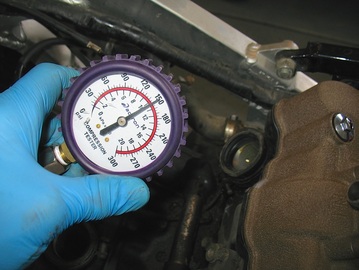 Before firing up Project 19 there's some details to attend to: Once the valve check is finished (only four in need of adjustment), the compression is measured. A proper compression check involves a warmed up engine, but most of my projects aren't so fortunate and I have to settle for a cold check on cylinders/valves that may not have been run for years. Still, any compression check is a good indicator of major internal engine issues and so is a must-do. Project 19 does well with all cylinders reading between 140-150. Next up is an issue I occasionally see with the side fairing support posts. The post's threads sometimes jam in their frame bracket and upon removal the soft aluminum threads twist off. The fix is a careful center-drilling of the old post material (trying not to damage the old threads) followed by re-tapping with the same thread size. Only once have I had to drill & tap to a larger diameter thread. Both sides of this bike were damaged.  Well, this can't be good. Here we have a fried 3-wire connector between the stator leads and the regulator/rectifier. When the R/R fails the wires heat up (they carry about 75 amps IIRC) and the high resistance in these little blade connectors results in this mess. This is a fairly common problem with this era of Japanese bikes and Hondas are not exempt. As late as 2005 Honda had to issue a VFR800 recall for this sort of thing. The problem stems from a bad R/R design and is way more complicated than my analog brain can follow, but the real fix is a better R/R, like Rick's (http://ricksmotorsportelectrics.com). This particular bike has an unknown replacement R/R in place so I elected to make the repair and test the charging system later when the bike is up and running. 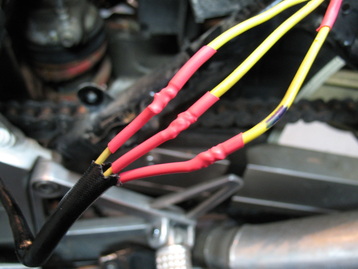 And here's my repair. No high-resistence connectors for me. Nope. Hardwire the stator leads with a solid soldered joint. Leave as much excess wire as possible so a future repair can be easily done. NOTE: The three yellow wires are not particular about their partners — they can be reattached to any one. 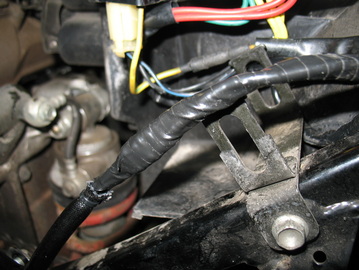 After individually wrapping the joints, the entire length is taped and tucked into place. Job done. All that's left is to mount up a carb set, top off the coolant, fire the engine and see if the electrons are moving as they should. 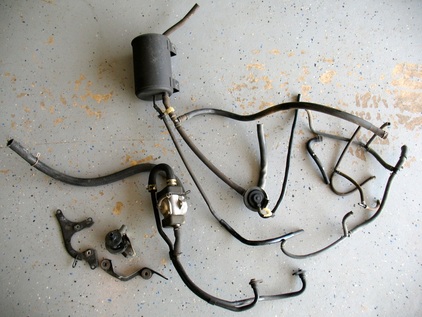 Work has begun on the newest member of the hoard, #19, an '86 VFR700. Back in the day there were both "49-state" models and California-spec bikes. The difference is in the plumbing—emissions plumbing, that is. These were part of the first wave of "EPA" bikes in the U.S. The various bits of hardware, shown at left, accomplished two things (as far as I can tell). The charcoal canister cleaned up some of the carburetor venting and the air pump injected air near the exhaust port of cylinders #2 & 4. The idea was that the fresh air will give any unburned exhaust gas a chance to burn itself up after leaving the engine, thus producing cleaner exhaust at the tail pipe. On the next generation of VFRs, these injection ports were added to cylinders #1 & 3 as well. The whole contraption was obviously effective enough to satisfy the feds back in the day, but 35 years later it all produces a lot of potential leaks and no way to test whether it actually still functions as intended. So, I vote to eliminate the system as a whole. 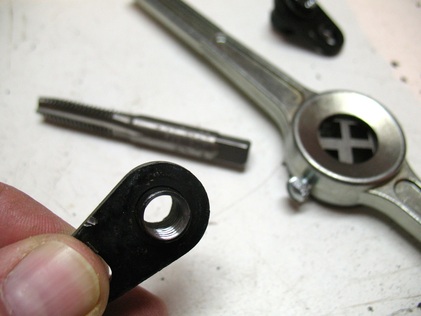 The fix is pretty simple. Remove all the hardware, plug the carb ports (five total) and plug the air injection port at #2 and 4. My cheap & simple fix for the injection port is to cut the port fitting off of its long metal tube, tap a course 3/8" thread into the (former) air passage, fit a shortened bolt coated with gasket cement or JB Weld, give it a coat of black engine paint and bolt it back up to the engine block. "Job done," as Edd China used to say. 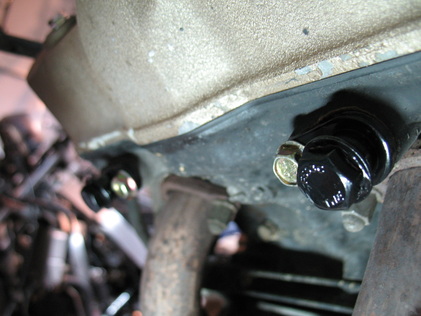 To my knowledge this emissions system is the only difference between the two versions. This clip from the old TV show 21 Jump Street always makes me cringe...and not for the rider. Number 18 is a 1986 VFR750 R/W/B with 10K miles showing. Yesterday I began stripping the bike to prepare for its first start-up in at least seven years. This always begins with removing the bodywork followed by getting the carburetors on the bench. With the fuel tank off I was greeted by this "high performance" modification. 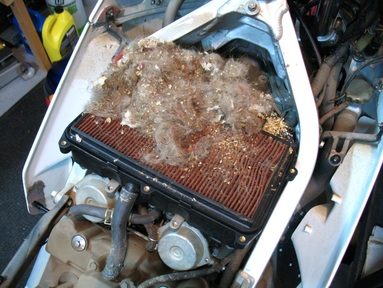 Peering through the many hi-speed holes I glimpsed some fuzzies, which past experience has told me would be a mouse house. Sure enough. Amazingly, no other evidence of the little critters could be found. The carbs appeared clean and shiny. I once had project where the mouse pee had worked its way downward through the air filter and soaked the carbs, freezing the butterflies in place. These look great. Problem is, the throttle shafts are locked in place, with no obvious clue why. That will require some further investigation. 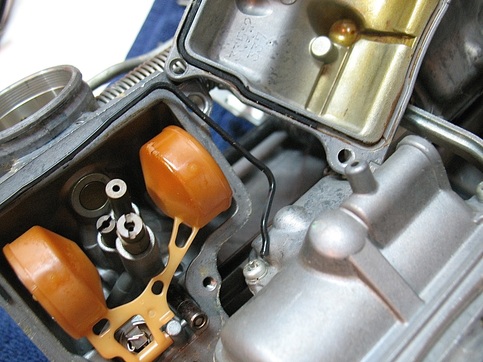 The old fuel, which long ago turned to a puddle of varnish in the fuel tank, must have been drained or evaporated away before solidifying in the carb bowls. They too look very clean. 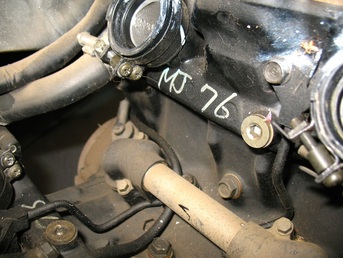 With the carbs removed I found only a nice protective layer of shop dust in the cylinder valley, with the factory markings clearly displayed in pale blue. I've found these on all my VFRs and assume they were some sort of engine assembly notations. With some fogging oil sprayed into the cylinders, the engine turned over normally by hand. Next up I'll adjust the valve clearances, do a compression check, remount a fresh set of carbs and see if she wants to run. Update: Next day the engine fired right up and warmed up normally with a jetted set of carbs installed. The Kerker sounds great. All the valve clearances were .001" tight, and the compression readings were nicely consistent. Now I'll remove the carbs and begin detailing the rest of the bike. 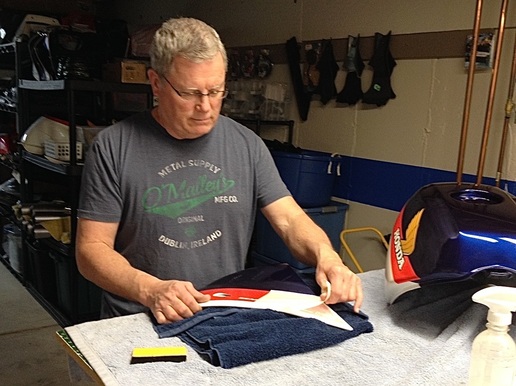 Headlight fairing Headlight fairing After two tries at color-matching the red, white & blue for the '86-87 VFRs, it's time to apply the reproduction decals from CBDecals.com. My impression is that the decals are high quality and very accurate in color and fit. This task took me an entire morning...with a little learning curve taking some extra time. Now back to the painter for the final clearcoat and some lucky Interceptor gets a fresh set of clothes. Over the winter hibernation, I decided to shorten and core a set of 1986 OEM mufflers. Yesterday I fitted them to a project bike and give them a first listen. The pipes are loosely fitted, not even clamped in place, so there's some additional noise, and the bike is also being run inside a garage. There's some visible moisture seen — it was 48-degrees yesterday! I think the mufflers are a success — good mellow sound without the straight-pipe noise. They really bring out the V4's uneven firing cadence. The bike is project #14, an '87 VFR700 F2. I've had this one for eight months and this is the first time I've heard it run. After completing some basic maintenance (valve adjustment, carb clean/jet/sync, compression check, spark plugs) it was ready to fire. The old girl fired right up, warmed up normally and runs great. Success. Now that I know I have a fine running engine, the rest of the bike can be finished. Here's a short video of the test. 2010 VFR1200 in Appleton, WI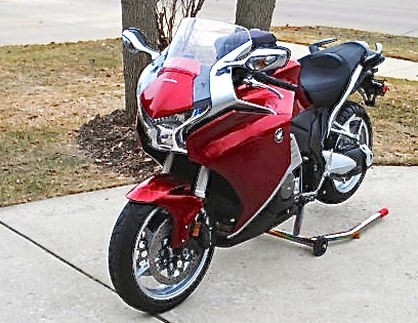 EBay item number 222058183950 EBay item number 222058183950 The 1200 Interceptor failed to take the world by storm. I'm biased, of course, but Honda's 2010 redesign of the Interceptor concept arguably produced the finest true sport-touring motorcycle in production. Power, refinement, smoothness, optional dual-clutch electric shift transmission, fit & finish a cut above, shaft drive. Yes, they were expensive...but no longer. Here we have a 2900-mile first-year example in what appears to be perfect condition. The seller is including the Two Brothers pipe, Pit Bull center stand and two Shoei (!) helmets. This "base" model had a 2010 MSRP of $16,000 and is now offered for a buy-it-now of $6500. Add heated grips and find a set of factory hard bags and you have an exceptional road bike that could take a proud owner through the rest of his or her riding career, whether that's two years or twenty. What a deal. Cycle World's original VFR1200 road test: http://www.cycleworld.com/2010/05/17/2010-honda-vfr1200f-road-test/ 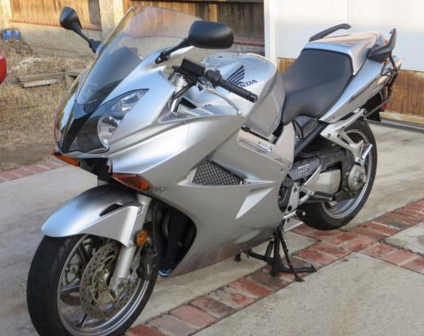 2005 VFR800 Hammer Down at $3200 Recently sold via eBay, this silver 800 Interceptor V-tec found a lucky new owner at a bargain price. Featuring 18,000 miles and a collection of extras, including factory saddle bags, bike cover, Battery Tender, two helmets and even a tow hitch carrier. The photos show what appears to be a very clean and cared for VFR. I hope the new owner can arrange a fly-n-ride from L.A. |
THE SHOP BLOG
|




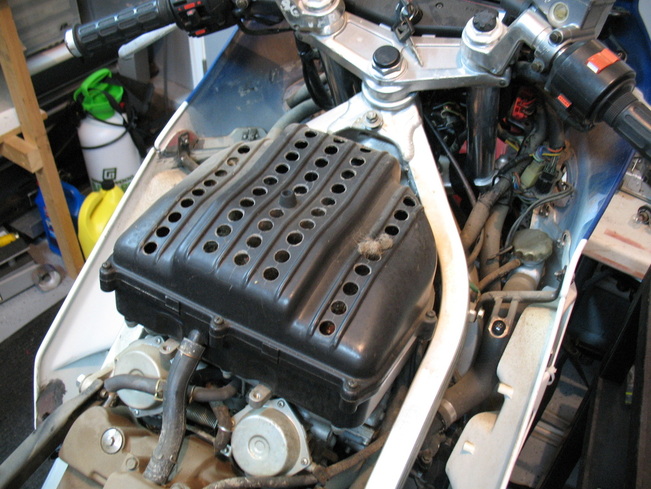



 RSS Feed
RSS Feed